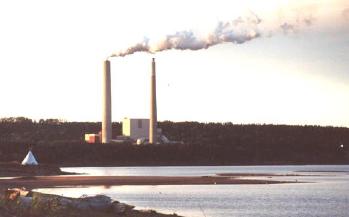July was not a particularly good month for the Dalhousie Thermal Plant.
For most of the month, the stack, which overlooks the town and
surrounding area, has been producing conspicuous spumes of that same
brown smudge which prompted several aggressive columns a couple of
years ago and which led NB Power to install supposedly state-of-the-art
scrubbers to alleviate the situation.

I had been restraining the temptation to go back on the warpath because
I have been convinced that plant engineers have been trying mightily to
correct and contain the situation. In the main I think that my
restraint has been justified. I received a telephone call recently from
one of the plant engineers, the same official who has been providing us
with monthly emission reports for the past two years; he was anxious to
explain the current situation and the steps which the commission has
been taking to rectify it. The bottom line was that, yes, there is a
problem, but that it should be solved by early this month (August).
I accepted his explanation and expressed my appreciation for his
willingness to offer it as well as for the broader efforts being made
to deal with what has become an embarrassingly persistent problem.
However, I continue to cringe each time I see that smudge and, at
times, I, too, am embarrassed.
On one such occasion, I was leading a kayak tour from Inch Arran
Park. It was a gloriously beautiful morning; the water was calm and
there was only a trace of surface wind. We rounded the Bon Ami Rocks
and pointed the kayaks in the general direction of Eel River Bar. And
then I saw the full extent of the smudge from a different perspective
than the one with which I am most familiar. The plume rose almost
straight up for what looked to be about a hundred feet before drifting
off toward the southwest. As it began to drift, it also disintegrated
into that yellowish-brown streak that signified its burden of sulpher.
From our perspective, we could see it spread out - over Dalhousie
Mountain, across Eel River Bar, back toward Balmoral and Dundee, even
down toward Charlo. In order to see blue sky, we literally had to turn
around and face back to the direction from which we had just come.
At such a time, I could only wish to be somewhere else because I know
that the questions are going to come: What is that plant? What on earth
are they burning? Is it always that filthy? Do you people have a lot of
asthma/cancer because of that stuff? Is anyone doing anything about it?
Has it always been like that?
Now, when I am out on the water conducting a kayak tour, I want to talk
about the birds, about the geological formations, about the fossils.
Mostly I want to share my own sense of wonder and joy over the beauty
of this place. I do not want to have to be explaining, or protesting,
or defending, or rationalizing or even discussing this abberation on
the natural scene. On this particular occasion, I tried to impart a bit
of enthusiasm for the efforts that NB Power oficials are making, but I
have to confess that it was a struggle even to try to be fair and
objective.
I have argued for years that the responsibilities of an
environmentalist, as I define them, include being fair and patient.
That means recognizing that problems do not disappear overnight even
when the will to correct them is there. In turn, that implies that I do
not consider it fair to go on the attack every time a manifestation of
a problem arises. However, it does not mean going to sleep either; it
does not mean continuing to ignore the problem simply because efforts
are being made to correct it. At some point, this problem has to be
fixed, or it is going to be time to start lobbying for a radical
solution to it.
I have to suggest that the time for solutions has about passed; either
the plant is going to work as it is supposed to, or it should be shut
down.
"Grains of Sand" from the Campbellton Tribune issue of September 19th.